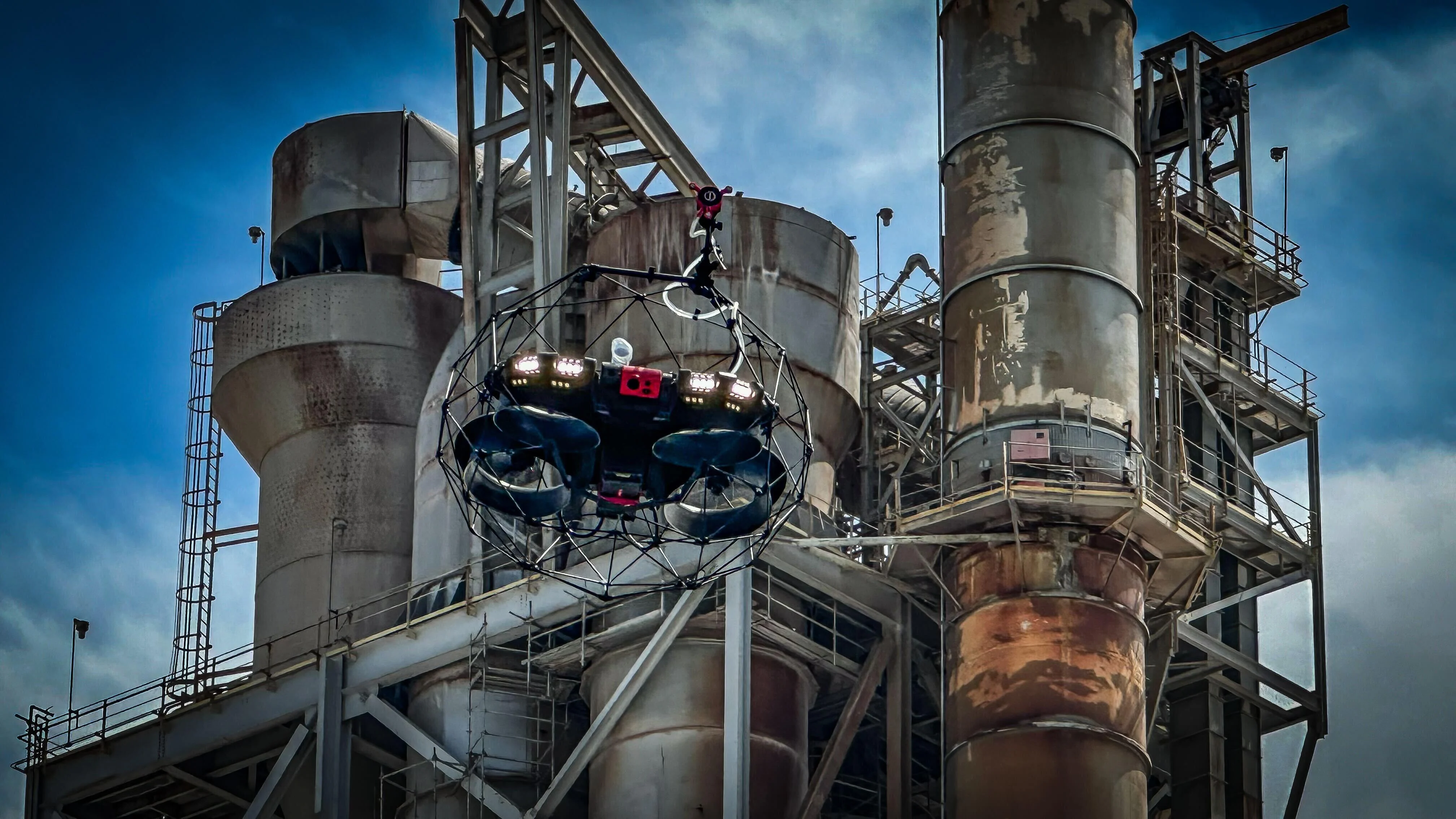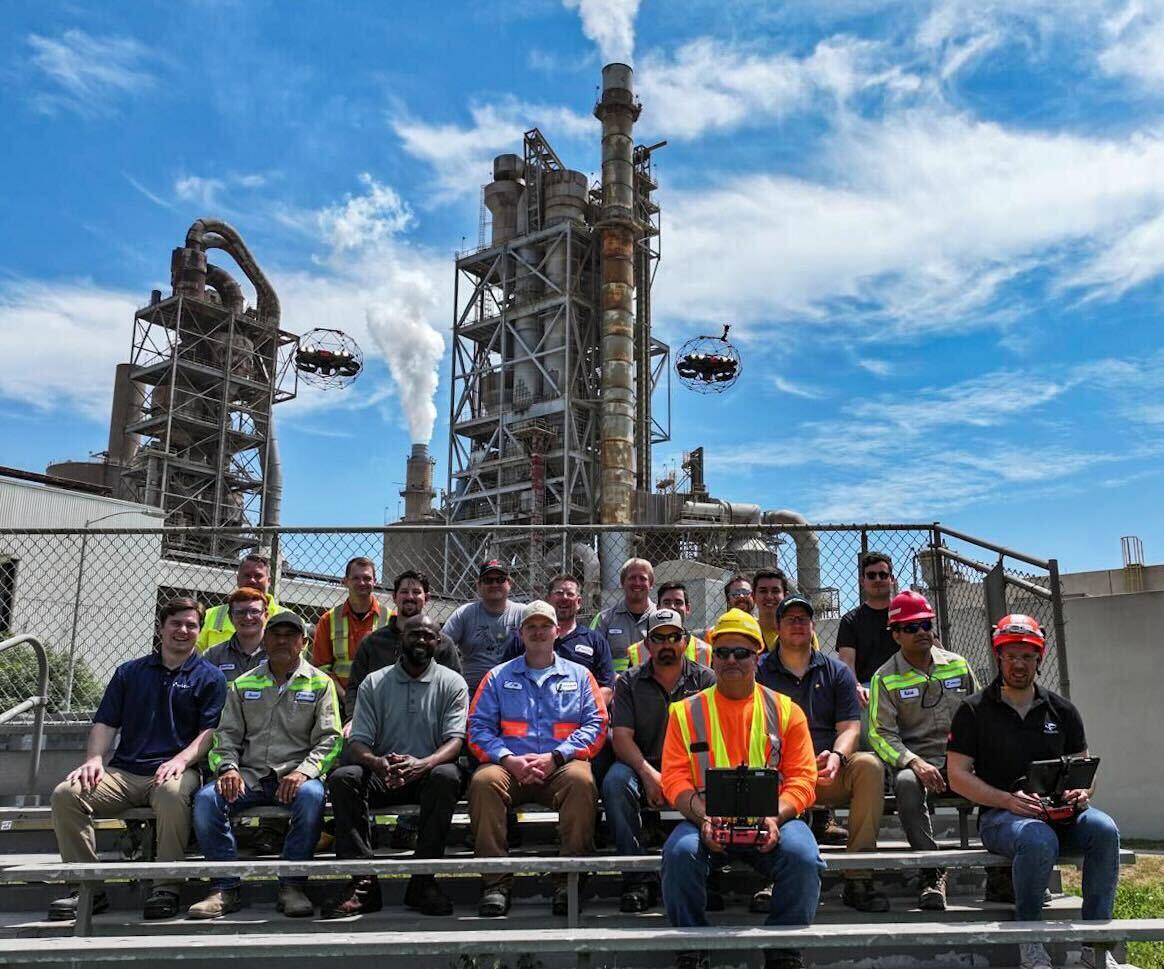Â
Holcim was one of the first companies to embrace Elios drones for inspections, using this cutting-edge technology to drive innovation through their Plants of Tomorrow initiative—a project aimed at integrating Industry 4.0 solutions across their facilities. By adopting drone technology, Holcim has been able to transform how they monitor and manage their industrial assets, making operations safer, more efficient, and more data-driven.
The partnership between Flyability and Holcim began in 2016 at Holcim Eclepens, where they tested early prototypes. Fast forward to 2024, and Holcim now operates a global fleet of 42 Elios drones, with over 100 trained pilots stationed around the world. This collaboration not only supports Holcim’s vision of becoming an industry leader in innovation, efficiency, and safety but also aligns with Flyability’s mission of sending drones into dangerous environments instead of humans, keeping people safe in high-risk areas.
Holcim has experienced significant benefits from using Elios 3 drones in the cement industry. These drones allow for safer access to the interiors of clinkers and silos, collecting both visual and LiDAR data from within critical infrastructure. The drones are particularly effective in dusty conditions, delivering clear and accurate data even in challenging environments. By using drones, Holcim reduces risks for its employees while gathering essential data faster and more cost-effectively, enhancing their overall asset management strategy. This is why they trust Elios drones so much and have built such a large and capable fleet.

The North American Holcim Drone Days took place at Midlothian Plant in Texas.Â
In June 2024, Flyability and Holcim hosted the third edition of the Holcim Drone Days, marking the second in North America. A total of 17 Holcim pilots from 9 different sites across the region attended, along with Flyability representatives. Building on the success of the 2023 event in Lausanne, this session featured expert talks, custom training, and opportunities for pilots to share their experiences and inspire each other to explore new projects and use cases.
Expert Talks on Drone Inspections in Cement
The Holcim Drone Days provided a valuable platform for knowledge exchange between Holcim and Flyability. Flyability shared insights into future developments for the Elios drones, discussing how to move beyond basic inspections and integrate drones more deeply into reporting and communication processes. They also invited James Comeau from Glencore Kidd Operations to speak about their journey from early adopters in mining to having full-time drone pilots with well-established procedures.
Meanwhile, Holcim pilots presented their own experiences, sharing how they're using drones in their respective plants. These presentations were incredibly informative, as they highlighted the diverse applications of the Elios drones and helped quantify the value of drone usage across different facilities. With pilots of all experience levels attending, the event was a great opportunity for growth and collaboration within the program.
Customized Training for Holcim Drone Inspections
The event took place at the Midlothian Plant in Texas, offering a real-world setting ideal for hands-on training. Given the dusty and confined nature of many cement plant environments, Flyability developed a tailored training program focused on improving pilot skills in these conditions. Pilots learned best practices for flying in low-visibility settings and how to handle unexpected situations, including how to respond to the fear of losing a drone during an inspection.
They also tested the Elios 3’s Return-to-Signal feature, allowing them to push the limits of the drone safely. Additionally, the training covered the use of new payloads, such as ultrasonic thickness measurement and surveying tools, expanding the capabilities of the Elios drones beyond visual inspections. Pilots explored how to process and manage data effectively, supporting initiatives like Scan to BIM, which aligns with Holcim's long-term vision of digital transformation.

Team photo! The North American pilots from Holcim with the Flyability team
An Example of Fostering Innovation Through Drones
The North American Drone Days showcased the spirit of innovation that runs through Holcim’s pilot teams. Led by David Hull, Manufacturing Support Coordinator at Midlothian Plant, the U.S. drone program is already evolving collaboratively. Pilots meet biweekly to discuss their experiences, but the Drone Days allowed them to connect in person and learn from each other’s workflows.
The sessions helped build stronger relationships among the pilots, providing them with new ideas and skills. Less experienced pilots learned from their more seasoned colleagues, while veterans got a glimpse of what's coming next from Flyability. The roundtable discussions allowed for meaningful exchanges between Holcim and Flyability, leading to fresh ideas on how to support each other moving forward.
Back at HQ in Switzerland, the Drone Days team called the event a huge success, bringing together passionate individuals dedicated to using drones for safer and smarter inspections. They expressed gratitude to David Hull and Aaron Toles for their coordination efforts, as well as the plant manager in Texas for enabling the event and providing a space for training and collaboration.
This was just the first Drone Days event of 2024, but its success sets the stage for more events in the future. Both Flyability and Holcim are committed to building an exciting and innovative drone program that positions Holcim as a leader in the industry and a pioneer in technological advancement.
Short for [reinforcing bar," rebar is refers to metal – usually steel – that`s used to help increase the tensile strength of concrete for a variety of needs, including many of the most common construction types you see every day.
Concrete is known to be weak in the areas we just mentioned, at least compared to steel and other metal types. If this reinforcement was not used, these structures would at-risk of falling apart.
Rebar usually will be built so the metal component is not visible within the structure. Rather, it will be buried within the concrete. It`s usually made with ribs rather than smoothly, allowing it to avoid slippage within its structure.
How Rebar is Made
As we noted above, the most common material for rebar use is steel, which is used because of its excellent tensile properties. It`s often made from forms of recycled steel, which will be melted down using an electric arc furnace, cooled using billets, and then stored until it`s needed.
From here, billets can be reheated to an elevated temperature and fed through extrusion tools, then necked down until its proper size is reached. Finally, it will be tooled to create the proper ribbing, which we noted above is in place to prevent slippage within concrete. Then it will be sheared to the proper length, and it`s ready to go.
Carbon Steel Deformed Steel Rebars,Reinforcing Steel Rebar For Construction,Hot Rolled Steel Rebar,Deformed Steel Rebar
SHANDONG HUITONG STEEL CO.,LTD , https://www.cnmetalsupply.com